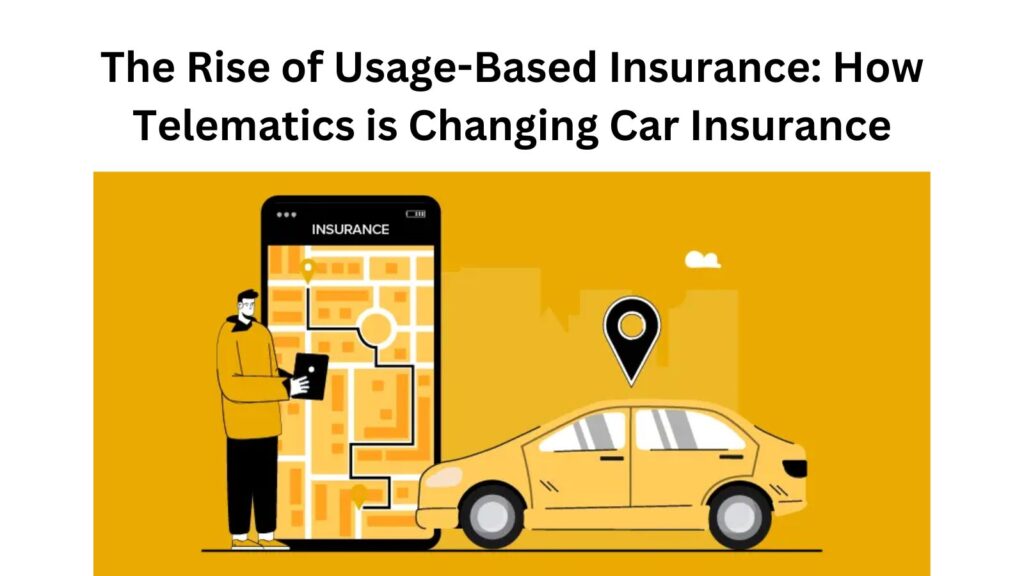Insurance premiums have long been a topic of frustration for many drivers. Why should someone who drives cautiously and follows the rules of the road pay the same as someone with a history of speeding tickets? Usage-Based Insurance (UBI) is changing car insurance. It uses telematics to set premiums based on your driving habits.
This new approach to car insurance is gaining traction worldwide, and it’s easy to see why. Smartphones, connected cars, and new telematics devices help insurers track driver behavior. This allows them to offer fairer and more personalized rates.

In this article, we will look at usage-based insurance. We’ll see how telematics technology is important. Then, we’ll discuss how these changes are transforming the car insurance industry. We’ll also weigh the pros and cons, share real-life examples, and help you understand how this trend could impact your wallet.
Ready to see how telematics and UBI are changing the game? Let’s dive in!
What is Usage-Based Insurance (UBI)?
Contents
Usage-Based Insurance is a type of car insurance. Your premiums depend on how much you drive and how safely you drive. UBI focuses on real driving behavior instead of age, gender, or driving history. This gives insurers a clearer view of risk.
Telematics Technology in UBI
At the heart of UBI is telematics—the technology that collects data about your driving habits. Telematics devices usually connect to your car in two ways. You can plug them into the OBD-II port. This is the same port mechanics use to check car issues. Alternatively, you can use a smartphone app to operate them. These devices monitor things like:
- Mileage: How far you drive each day, week, or month.
- Speeding: Whether you exceed speed limits.
- Braking and Acceleration: How smoothly you drive, including harsh braking or rapid acceleration.
- Time of Day: Whether you drive at high-risk times, such as late at night.
- Route Taken: Whether your routes are high-traffic or accident-prone areas.
This data is sent to your insurance company, and your premium is adjusted based on your driving behavior. If you’re a safe, low-mileage driver, you’ll likely pay less. On the other hand, risky drivers who frequently speed or drive long distances may face higher rates.
How Does Usage-Based Insurance Work?
The process of getting UBI is pretty straightforward, but it can vary slightly depending on the insurer. Here’s how it generally works:
- Sign Up for UBI: You choose a UBI program from your insurance provider. The company might send you a telematics device or have you download a mobile app to track your driving.
- Install the Device or App: If it’s a car-mounted device, it’s simply plugged into your car’s OBD-II port. If it’s a smartphone app, you just need to install and enable it.
- Start Driving: As you drive, the telematics system collects data on your driving habits. This data is sent back to your insurance provider.
- Monitor Your Driving Habits: Some insurers give you access to a portal or app where you can track your driving score or habits. This can help you improve your driving and earn discounts.
- Adjust Your Premium: After 30 days to 6 months, the insurer will review your driving data. Then, they will adjust your premiums based on what they find.
The Pros of Usage-Based Insurance
The shift toward UBI is revolutionizing the car insurance industry, and for good reason. Here are the main benefits:
1. Fairer Premiums Based on Actual Behavior
The main benefit of UBI is that it rewards drivers based on their actions. It doesn’t depend on factors like age, gender, or location. If you’re a cautious, safe driver, you’ll likely see your premiums drop. Conversely, if you’re a high-risk driver, you’ll pay more, which makes sense because your behavior is directly linked to your risk on the road.
Real-Life Example:
Let’s say you’re a 25-year-old male driver (historically considered a high-risk group). You drive very carefully, avoid speeding, and stick to the speed limits. With UBI, the insurer sees your safe driving. They then offer lower premiums based on your real risk. This is better than charging a flat rate just because of your age.
2. Pay-Per-Mile Savings
Many UBI programs use pay-per-mile or pay-as-you-drive (PAYD) models. In these programs, your premium depends on how far you drive. This is great for people who don’t drive much. This includes those who work from home, live in cities with public transport, or don’t go on long road trips.
Fun Fact: According to the Insurance Information Institute, the average U.S. driver spends around 13,500 miles per year on the road. If you’re only driving a fraction of that, pay-per-mile insurance could save you a significant amount.
3. Safe Driving Discounts
Safe drivers often get rewarded with discounts. These can range from small savings to significant cuts in premiums. If you always drive under the speed limit, avoid quick starts, and brake gently, your insurance costs might go down.
Some insurers make safe driving fun. They offer rewards or points. You can use these for discounts, gift cards, or donations to charities.
4. Increased Transparency and Control
UBI gives drivers more control over their premiums. Instead of being at the mercy of age or geographic factors, you can directly influence the price you pay by improving your driving habits. This can also make it clearer how insurers set premiums. It reduces the mystery many consumers feel about their rates.
The Cons of Usage-Based Insurance
While UBI offers many advantages, it’s not without its drawbacks. Here are a few of the downsides to consider:
1. Privacy Concerns
Telematics devices track a lot of personal data about your driving habits. For some, this level of surveillance can be uncomfortable, raising questions about how this data is used and stored. Could the data be shared with third parties? Could insurers raise premiums based on factors like when and where you drive, even if you’re a safe driver?
Real-Life Example:
Some customers have expressed concerns about “tracking” by their insurers.
2. Limited Availability
UBI is still relatively new and might not be available in all regions or through all insurers. Even if it is available, not every insurer offers the same discounts or terms, making it a bit tricky for consumers to choose the best plan for their needs.
3. Upfront Costs
Some insurers may charge an initial fee for the telematics device or app. While the potential savings over time could outweigh these initial costs, it’s something to keep in mind when choosing whether to opt for UBI.
4. Potential for Increased Premiums for High-Mileage Drivers
While low-mileage drivers can save a lot, those who drive long distances or in higher-risk areas might see their premiums rise. So, if you’re someone who drives a lot for work or travel, UBI might not always be the most economical option.
Real-Life Stories: How UBI Has Helped Drivers
Story 1: Sarah, the Low-Mileage Driver
Sarah works from home and rarely drives her car. She decided to switch to a UBI plan offered by her insurer. After six months of tracking, she was pleasantly surprised when her premium dropped by 30%. With UBI, she only paid for the miles she drove, and her safe driving habits were rewarded with an additional 10% discount. Sarah’s annual insurance premium dropped from $1,200 to $780—significant savings for someone who drives less than 5,000 miles a year.
Story 2: Mark, the Safe Driver
Mark is a 45-year-old driver with a clean driving record. He switched to a UBI plan to see if his careful driving could save him money. After six months, his insurer gave him a 15% discount. He earned this by driving under the speed limit, avoiding sudden braking, and staying off the road during rush hour. Mark’s savings weren’t huge, but it was enough to make him feel like his good habits were finally paying off.
Conclusion: Is Usage-Based Insurance the Future?
Usage-Based Insurance is a fast-growing trend in car insurance. It lets drivers affect their premiums by how they actually drive. Telematics devices help insurers provide fairer rates. They reward safe drivers and low-mileage individuals with discounts. UBI has its challenges. There are privacy concerns, limited availability, and possible premium hikes for high-mileage drivers. These are all important factors to consider.
In the end, UBI is the future of car insurance. It offers a clearer and more flexible way to help drivers save money. If you’re a safe, low-mileage driver, UBI could be a great way to reduce your insurance costs.
Ready to explore usage-based insurance? Make sure to do your research and choose a plan that aligns with your driving habits and preferences.
MUST READ:
Understanding Renters Insurance: Why It’s More Important Than You Think
Frequently Asked Questions
1. What is UBI insurance?
Usage-Based Insurance (UBI) is car insurance that sets premiums based on your driving habits. This includes mileage, speed, and when you drive. It’s powered by telematics technology such as smartphone apps or car-mounted devices.
2. How do I qualify for UBI insurance?
Most insurance providers ask you to join their UBI program. After that, you’ll get a telematics device or need to download an app to track your driving. Qualification depends on your insurer’s specific program.
3. Can I save money with UBI insurance?
UBI rewards good driving behavior, so you’ll likely pay less if you stick to the speed limit and avoid harsh braking.
4. Will my privacy be compromised with UBI?
UBI involves tracking your driving habits, which may raise privacy concerns. Most insurers have privacy policies in place to protect your data, but it’s always a good idea to read the terms carefully before signing up.
